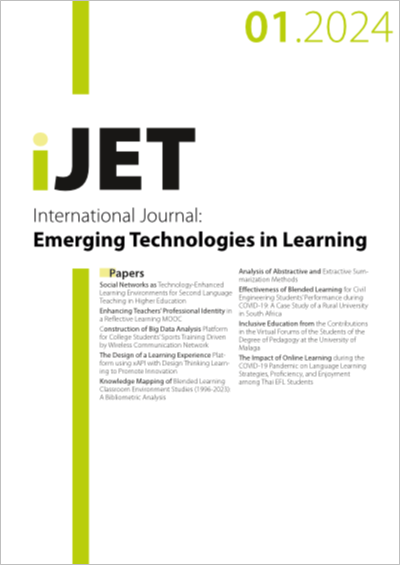Knowledge Mapping of Blended Learning Classroom Environment Studies (1996-2023)
A Bibliometric Analysis
DOI:
https://doi.org/10.3991/ijet.v19i01.43569Keywords:
bibliometric analysis, blended learning, classroom environment, CiteSpaceAbstract
The classroom environment has undergone a fundamental shift since the era of information and communication technologies, with blended learning (BL) gaining increasing attention in recent years. In light of the limited number of studies that have reviewed the integration of BL and classroom environments in scientific publications, the present study analyzed a total of 283 publications from the WOS database. This analysis provides a comprehensive bibliometric analysis, which reveals the following key findings: Firstly, research in this area has shown progressive development, indicating its maturation over time. Secondly, Garrison emerged as the author with the highest number of citations in 67 records, while Kim stood out as the most prominent author citing Garrison. Thirdly, the top three countries and journals that have made the most significant contributions to these studies are the United States, China, and Spain, along with the journals Computers & Education, Internet and Higher Education, and the British Journal of Educational Technology. Fourthly, the most cited articles are Boelens et al. (2017), O’Flaherty et al. (2015), Abeysekera et al. (2015), Bernard et al. (2014), Thai et al. (2017), and Rasheed et al. (2020). Finally, it was not until 2008 that more keywords such as “computer-mediated communication” (related to the technological environment), “cooperative or collaborative learning” (related to the social environment), “engagement,” and “selfefficacy” (related to the cognitive environment) began to receive more scholarly attention. The research on engagement is considered to be an emerging trend.
Downloads
Published
How to Cite
Issue
Section
License
Copyright (c) 2023 Gengsheng Xiao, Min Zhang

This work is licensed under a Creative Commons Attribution 4.0 International License.



